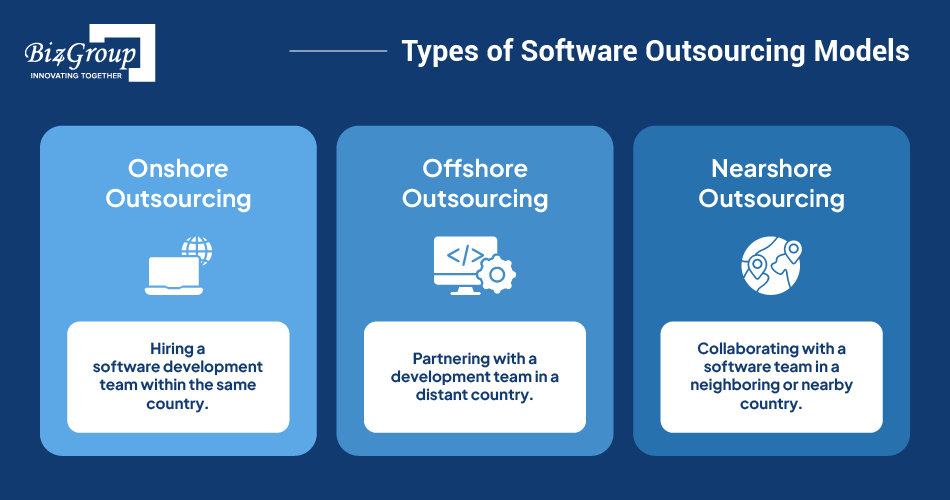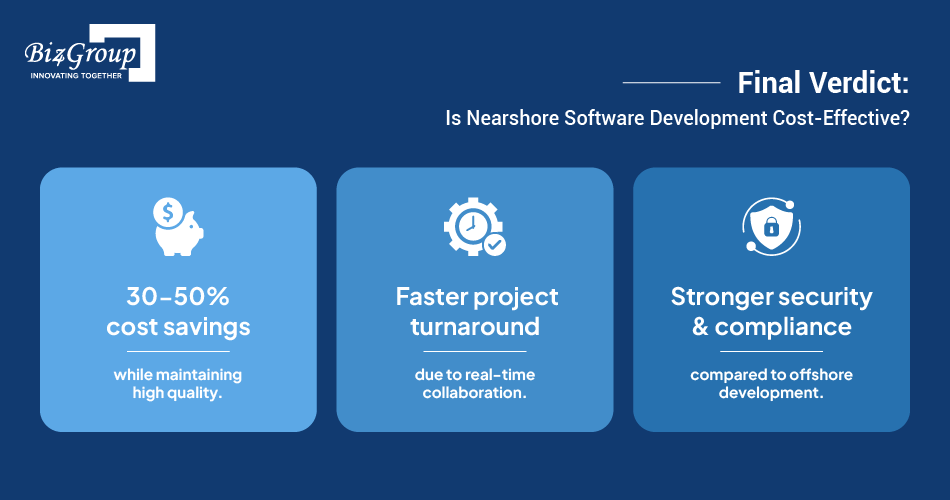Basic AI Chatbot Pricing: A simple chatbot that can answer questions about a product or service might cost around $10,000 to develop.
Read More

TL; DR

Nearshore Software Development Offers Cost-Effective Solutions – Businesses can save 30-50% on development costs while maintaining high-quality standards with a trusted nearshore software development company.

Seamless Collaboration with Nearshore Software Developers – With minimal time zone differences, nearshore teams ensure real-time communication, faster iterations, and efficient project execution.

Nearshore Software Development Services Enhance Scalability – Companies can scale development teams up or down based on project needs without the overhead costs of hiring in-house talent.

Better Security & Compliance with Nearshore Teams – A reliable nearshore software development company follows strict data security protocols (GDPR, HIPAA, SOC 2) to protect business-critical information.

Agile Development Boosts Project Efficiency – Nearshore software developers use Scrum, DevOps, and continuous integration to deliver high-quality software faster.

Choosing the Right Nearshore Partner is Crucial – Partnering with an experienced nearshore software development services provider ensures smooth workflows, strong technical expertise, and a successful project outcome.
Finding the right approach to software development can be a challenge for businesses looking to scale efficiently while managing costs. With increasing demand for digital transformation, companies are constantly exploring ways to optimize resources without compromising quality. Nearshore software development has emerged as a strategic solution, offering a cost-effective and collaborative approach by outsourcing to teams in neighboring countries.
According to Deloitte’s Global Outsourcing Survey, nearly 70% of organizations have selectively insourced portions of their previously outsourced scope in the past five years to gain more control and build strategic capabilities internally. However, for businesses looking for flexibility and efficiency, outsourcing remains a strong option, with nearshore software development services becoming a preferred model due to reduced time zone differences and enhanced collaboration.
In this Comprehensive Guide, We’ll Cover:
What is nearshore software development? – A clear definition and key characteristics.
Benefits of nearshoring – Why businesses prefer this model over offshore and onshore outsourcing.
How to choose the right nearshore development partner – Essential factors to consider.
Cost insights – A breakdown of nearshore development expenses and how it optimizes costs.
Best practices for success – Proven strategies to ensure smooth execution.
Let’s dive in and explore why nearshoring software development is the smart choice for businesses seeking high-quality, cost-efficient, and scalable software solutions.
Nearshore software development is a strategic outsourcing model where businesses delegate software development tasks to a third-party team located in a neighboring or nearby country. This approach bridges the gap between onshore outsourcing (hiring local developers) and offshore outsourcing (working with teams in distant countries), offering a balance of cost efficiency, cultural compatibility, and real-time collaboration.
Companies opting for nearshore software development services can leverage skilled development teams in countries that share similar time zones and cultural aspects, ensuring smoother communication and workflow alignment.
For example, a U.S.-based company may outsource software development to teams in Mexico, Costa Rica, or Colombia, instead of hiring developers from India or the Philippines (offshore outsourcing). This setup reduces time zone-related challenges while still benefiting from cost savings and access to top-tier talent.
One of the defining features of nearshore software development is the geographical closeness between the client and the development team. Since nearshore providers operate in neighboring or nearby countries, businesses can:
Reduce travel costs and save time – Face-to-face meetings can be scheduled with minimal effort.
Improve project oversight – Easier collaboration and management due to proximity.
Enhance team integration – More flexibility in engaging nearshore teams as extended workforce units.
For example, a European company in Germany may collaborate with a software development team in Poland or Ukraine, instead of outsourcing to teams in India or China. The close geographical proximity ensures seamless operations without major logistical concerns.
Unlike offshore outsourcing, where companies may face significant time zone differences leading to delays in communication and project execution, nearshore outsourcing ensures overlapping work hours.
Why is this important?
Real-time collaboration – Teams can communicate instantly without waiting hours for responses.
Faster issue resolution – Bugs, updates, and critical fixes can be addressed quickly.
More productive agile development cycles – Daily stand-up meetings, sprint reviews, and progress checks become easier.
For instance, a U.S. company working with a development team in Mexico enjoys a 1–2-hour time difference, allowing for effective daily coordination. In contrast, working with an offshore team in India may result in 8–12-hour differences, making real-time collaboration difficult.
Cultural and linguistic alignment plays a crucial role in the success of nearshoring software development projects. Nearshore teams often share similar work ethics, business etiquette, and communication styles, making collaboration smoother.
Key benefits include:
Fewer language barriers – Developers in nearshore locations often have strong English proficiency.
Aligned business values – Understanding of corporate expectations and work culture.
Higher engagement and productivity – Fewer misunderstandings lead to better teamwork and faster project completion.
For example, U.S. companies nearshoring to Latin America benefit from shared cultural influences and a growing number of English-speaking tech professionals, making project communication seamless.
Looking for cost-effective and high-quality software solutions? Partner with expert nearshore software developers today!
Get a Free ConsultationNearshore software outsourcing enables businesses to collaborate with development teams in neighboring or nearby countries, ensuring real-time communication, efficient project management, and high-quality software delivery. But how does it work on a day-to-day operational level? Let’s break it down into the key working aspects.
Unlike offshore outsourcing, nearshore development teams operate in similar time zones, allowing for real-time collaboration. Here’s how daily operations are structured:
Daily stand-up meetings – Teams start the day with quick check-ins using Agile methodologies (Scrum or Kanban). These meetings cover project updates, blockers, and next steps.
Real-time communication tools – Slack, Microsoft Teams, or Zoom are used for instant messaging and video calls.
Quick turnaround on feedback – Since both teams work during overlapping hours, businesses receive immediate responses and progress updates.
Regular progress reports – Teams provide detailed insights on task completion and potential risks.
For example, a U.S. company working with a nearshore team in Mexico can schedule a 10 AM meeting that suits both teams, whereas an offshore team in India would struggle with real-time coordination due to a 12+ hour time gap.
Nearshore software outsourcing follows Agile development methodologies, ensuring continuous progress and flexibility. The typical workday includes:
Sprint Planning – Teams break the project into smaller iterations (sprints) lasting 1-2 weeks.
Development & Code Reviews – Developers write and push code to repositories like GitHub, where senior engineers review changes.
Automated & Manual Testing – Quality assurance engineers conduct tests to catch bugs early in the cycle.
Demo & Client Feedback – Each sprint ends with a demo session, where businesses review progress and provide input.
By using Agile workflows, businesses working with nearshore development teams can track progress in real-time and make adjustments without waiting for long update cycles.
To ensure efficiency and transparency, nearshore teams use advanced project management tools such as:
| Tool | Purpose |
|---|---|
| Jira | Sprint planning & issue tracking |
| Trello | Task management & collaboration |
| Asana | Workflow tracking & productivity |
| GitHub/GitLab | Version control & code collaboration |
| Zoom/Google Meet | Video conferencing for discussions |
These tools help businesses monitor project progress, assign tasks, and track software development cycles effectively.
For instance, a nearshore team working on a fintech application for a U.S. client may use Jira to update sprint tasks, GitHub for code management, and Slack for instant team discussions.
One of the major advantages of nearshore software development over offshore outsourcing is the ability to resolve issues in real time. Here’s how teams handle bugs:
Automated testing – Continuous Integration/Continuous Deployment (CI/CD) ensures that each new code release is tested automatically.
Bug tracking systems – Jira or Bugzilla helps developers prioritize and fix issues.
Instant debugging sessions – Developers and QA engineers collaborate instantly to resolve critical issues.
User feedback integration – Businesses provide feedback, and nearshore teams make quick adjustments without delays.
If a critical bug appears in an e-commerce platform developed by a nearshore team, it can be fixed within hours instead of waiting until the next workday, which is common in offshore models due to time differences.

Ensuring data security and compliance is a crucial aspect of nearshore software outsourcing. To protect sensitive business information, nearshore teams follow:
NDAs & Data Privacy Agreements – Strict contracts to prevent unauthorized access.
ISO & GDPR Compliance – Ensuring software meets regulatory standards.
Cloud-Based Security Measures – Use of AWS, Azure, and Google Cloud for encrypted data storage.
Two-Factor Authentication & Access Control – Restricting project access to authorized personnel only.
For example, a healthcare startup in Canada outsourcing to a nearshore team in Colombia must ensure HIPAA compliance for patient data protection.
After software deployment, nearshore development teams provide ongoing support and maintenance, ensuring:
Performance monitoring – Identifying and resolving any software bottlenecks.
Regular updates – Keeping software aligned with business needs.
Security patches – Protecting against vulnerabilities.
User experience enhancements – Making adjustments based on client feedback.
For example, a SaaS company in the U.K. working with a nearshore team in Portugal may require monthly feature updates and bug fixes, ensuring the platform stays competitive.

When businesses seek to develop software without hiring an in-house team, they typically consider three primary outsourcing models:
Onshore Outsourcing – Hiring a software development team within the same country.
Offshore Outsourcing – Partnering with a development team in a distant country.
Nearshore Outsourcing – Collaborating with a software team in a neighboring or nearby country.
Each model offers distinct advantages and challenges. The choice depends on factors like cost, communication, time zone alignment, and project complexity. Below, we’ll explore these three models and compare their effectiveness.
Onshore outsourcing refers to hiring a software development team within the same country as the business. This model eliminates language barriers and ensures smooth communication but often comes at a higher cost due to local wages and operational expenses.
Pros:
✅ Same time zone – No delays in communication or meetings.
✅ Strong cultural alignment – No language or work culture barriers.
✅ Legal compliance – Easier to follow data security regulations.
Cons:
❌ High development costs – Software developers in the U.S., Canada, or Western Europe charge premium rates.
❌ Limited talent pool – Finding specialized skills locally can be challenging.
❌ Less cost efficiency – Not as budget-friendly as offshore or nearshore models.
💡 Example:
A U.S.-based retail company needs a custom e-commerce platform. It hires a software firm in New York to develop the solution. The project benefits from real-time collaboration but incurs higher development costs compared to offshore or nearshore alternatives.
Offshore outsourcing involves hiring a development team in a distant country (e.g., a U.S. company outsourcing to India or the Philippines). This model offers significant cost savings but presents challenges like time zone misalignment, cultural differences, and communication barriers.
Pros:
✅ Lower costs – Development rates in countries like India, the Philippines, and Eastern Europe are significantly lower.
✅ Access to a large talent pool – Skilled developers with expertise in various technologies.
✅ 24/7 development cycle – Teams in different time zones can work on projects round the clock.
Cons:
❌ Time zone differences – Can cause delays in communication and project execution.
❌ Cultural and language barriers – Potential for misunderstandings in requirements.
❌ Security concerns – Higher risks related to data protection and compliance.
💡 Example:
A U.K.-based fintech startup outsources mobile app development to a firm in India to reduce costs. However, due to an 8-hour time difference, feedback loops are slower, causing delays in project milestones.
Nearshore outsourcing is a middle-ground approach where businesses hire software development teams in neighboring or nearby countries. This model balances cost savings with real-time collaboration, making it a popular alternative to offshore and onshore models.
Pros:
✅ Lower costs than onshore – More affordable than hiring local developers.
✅ Minimal time zone differences – Enables real-time communication and faster feedback.
✅ Stronger cultural and language alignment – Fewer barriers compared to offshore outsourcing.
✅ Better control and quality assurance – Easier to manage teams due to geographical proximity.
Cons:
❌ Slightly higher costs than offshore – While still cost-effective, nearshore rates are higher than offshore locations.
❌ Limited talent pool compared to offshore – Fewer developers available in some regions.
💡 Example:
A U.S. e-commerce company outsources software development to Mexico instead of India. The 1-hour time difference enables seamless daily communication, improving project efficiency without the higher costs of onshore development.
| Factor | Onshore Outsourcing | Offshore Outsourcing | Nearshore Outsourcing |
|---|---|---|---|
| Cost | High | Low | Moderate |
| Communication | Excellent | Challenging | Good |
| Time Zone | Same | Significant Difference | Minimal Difference |
| Cultural Fit | Strong | Weak | Strong |
| Talent Pool | Limited | Large | Moderate |
| Legal & Compliance | Easy | Complex | Easier than offshore |
To select the best outsourcing strategy, businesses should assess the following:
Budget & Cost Efficiency – Offshore is the cheapest but nearshore offers a better balance of cost and quality.
Time Zone Considerations – Onshore and nearshore ensure real-time collaboration, whereas offshore can cause delays.
Project Complexity – If a project needs constant monitoring, onshore or nearshore development is preferable.
Cultural and Language Fit – Nearshore teams often have stronger cultural alignment compared to offshore developers.
Legal & Compliance Requirements – Onshore offers the easiest compliance, while offshore requires careful due diligence.
Understanding how different outsourcing models work in real-world scenarios helps businesses make informed decisions. Below are three case studies showcasing the advantages and challenges of onshore, offshore, and nearshore outsourcing.
A London-based insurance company hires a U.K. software development agency to build a claims processing system. The team works in the same office occasionally, ensuring strong collaboration but at a higher cost compared to offshore or nearshore models.
A U.S. tech startup outsources AI-powered chatbot development to an Indian firm. While the costs are 50% lower, delays occur due to time zone differences, and initial communication barriers require additional effort.
A Canadian logistics company outsources software development to Colombia, benefiting from:
✅ Lower costs than onshore
✅ Minimal time zone difference for real-time collaboration
✅ Strong cultural alignment for smooth communication
The project progresses faster than offshore due to better coordination, making nearshoring the ideal choice.
Reduce costs without compromising quality! Leverage nearshore software development services for faster, seamless project execution.
Talk to Our ExpertsNearshore development outshines other software outsourcing models by offering the perfect balance between cost efficiency, seamless collaboration, and high-quality service. Unlike offshore outsourcing, where time zone differences and cultural barriers can lead to delays and miscommunication, software development nearshore ensures real-time coordination. Companies partnering with a nearshore development company benefit from faster response times, streamlined project management, and greater flexibility in adapting to business needs. With nearshore teams operating in nearby countries, businesses can maintain agile workflows, conduct daily stand-ups, and receive immediate feedback without the challenges of offshore outsourcing.
Additionally, nearshore software solutions provide a competitive edge by aligning with the client’s cultural and linguistic expectations. Nearshore teams often share similar business ethics, work habits, and industry standards, reducing the risk of project misalignment. While onshore outsourcing offers cultural familiarity, it comes at a significantly higher cost. Nearshore development, on the other hand, delivers skilled talent at a lower price while ensuring that businesses retain full control over their software projects. This makes software development nearshore the most efficient and cost-effective choice for companies looking to scale their digital solutions without sacrificing quality.
Partnering with a nearshore company offers businesses a cost-effective and efficient way to develop high-quality software while ensuring seamless collaboration. The nearshore software development model combines proximity, cultural alignment, and skilled talent, making it an ideal choice for companies seeking scalable solutions without the limitations of offshore outsourcing.

One of the primary reasons businesses choose the nearshore software development model is its ability to reduce development costs while maintaining high standards. While onshore development is often expensive, nearshoring provides top-tier talent at a fraction of the cost, as labor rates in nearshore locations are significantly lower than in North America or Western Europe.
A nearshore company operates within a similar time zone as its client, allowing for real-time collaboration, faster response times, and quicker decision-making. This ensures that businesses can hold daily stand-ups, address critical issues immediately, and improve overall project efficiency—something that is often challenging with offshore teams due to significant time differences.
The nearshore software development model grants businesses access to highly skilled developers, engineers, and IT professionals who are experts in the latest technologies. Many nearshore locations invest heavily in tech education, ensuring a competitive and well-trained workforce that meets global development standards.
A major advantage of working with a nearshore company is the cultural and linguistic alignment with the client’s organization. This minimizes miscommunications, enhances teamwork, and ensures a smoother workflow, which can be a major challenge in offshore outsourcing. Additionally, nearshore teams often have strong English proficiency, making collaboration even more effective.
With the nearshore software development model, businesses can scale their teams up or down based on project requirements without long-term hiring commitments. This flexibility allows companies to adapt to market changes, accelerate development cycles, and optimize costs without the risks associated with hiring in-house teams.
Since nearshore teams work within the same or a similar time zone, they can accelerate development cycles, resolve issues quickly, and reduce project turnaround times. This makes the nearshore company approach ideal for businesses looking to deploy software faster and stay ahead of competitors.
Many businesses prefer nearshore software development models due to their strong regulatory compliance and data security measures. Nearshore teams often follow international security standards (such as GDPR or HIPAA), ensuring that businesses remain compliant with data protection laws while minimizing cybersecurity risks.
Also read: How To Build AI Software: A Comprehensive Guide for Founders
Choosing the right nearshore software development company is crucial for ensuring project success, efficient collaboration, and cost-effective development. By following a structured approach, businesses can find the perfect partner that aligns with their goals and delivers high-quality nearshore custom software development solutions.
Before starting your search, clearly outline your project requirements, goals, and technical specifications. Determine whether you need full-scale development, team augmentation, or specialized expertise in areas such as AI, cloud computing, or mobile app development.
💡 Example: If your company wants to develop a fintech application with strict security compliance, you must ensure that the nearshore software development company specializes in financial technology and adheres to data protection regulations.

Look for experienced and reputable nearshore software development services providers with a strong portfolio. Evaluate their expertise, past projects, and client reviews to assess their capabilities.
✅ Key factors to consider:
Years of experience in software nearshoring
Industry-specific expertise
Case studies and client testimonials
Certifications (ISO, GDPR compliance, etc.)
💡 Example: If you need nearshore custom software development for e-commerce, select a company that has successfully built similar platforms with payment integration and scalable architectures.
A nearshore software development company should be proficient in modern programming languages, frameworks, and agile methodologies to ensure high-quality and scalable solutions.
✅ Questions to ask:
What technologies does the team specialize in (React, Python, Node.js, etc.)?
Do they follow Agile, Scrum, or DevOps best practices?
What quality assurance measures are in place?
💡 Example: A company looking for nearshore software developers to build an AI-powered chatbot should ensure the team has expertise in machine learning, NLP, and cloud-based AI deployment.
Since software nearshoring requires seamless collaboration, it’s important to ensure the company’s communication style, time zone, and cultural alignment match your business.
✅ Considerations:
English proficiency and communication tools (Slack, Zoom, etc.)
Overlapping work hours for real-time collaboration
Cultural understanding and business ethics
💡 Example: A U.S.-based company partnering with a nearshore software development services provider in Mexico or Colombia benefits from minimal time zone differences, improving real-time discussions and faster issue resolution.
Your nearshore software development company should follow strict security protocols and legal compliance to protect sensitive data and intellectual property.
✅ Security aspects to verify:
NDA agreements and data protection policies
Compliance with GDPR, HIPAA, or industry-specific regulations
Secure development practices and encryption standards
💡 Example: If developing an AI healthcare application, choose a nearshore custom software development firm with expertise in HIPAA compliance to avoid legal risks.
Different nearshore software development services providers offer varied pricing models and engagement strategies. Understand the cost structure to ensure it aligns with your budget and project needs.
✅ Common engagement models:
Dedicated Team - A full-time team of nearshore software developers working exclusively on your project.
Staff Augmentation - Hiring developers to complement your existing in-house team.
Project-Based Model - A fixed-cost approach for a defined scope of work.
💡 Example: A startup needing MVP development may opt for a project-based model, while an enterprise looking for long-term software nearshoring may choose dedicated teams for continuous development.
Before committing to a long-term contract, conduct a small pilot project to evaluate the nearshore software developers' performance, communication, and technical abilities.
✅ What to assess during the trial?
Code quality and adherence to best practices
Response time and problem-solving approach
Ability to meet deadlines and project milestones
💡 Example: A company looking for nearshore software development services can start with a prototype or proof of concept (PoC) before scaling up to a full product.
By following these seven key steps, businesses can ensure they choose a reliable, cost-effective, and skilled partner for nearshore custom software development. Whether it's building a new digital platform or scaling an existing solution, the right nearshore software development services provider can drive innovation and long-term success.
Biz4Group—your go-to nearshore software development company for cost-effective, agile, and scalable solutions.
Let’s Build Something GreatOne of the biggest questions businesses ask before outsourcing software development is: "How much does nearshore software development cost?" Unlike offshore outsourcing, where rates vary significantly, nearshore software development offers a balance between affordability and premium-quality services. But here’s the catch—there’s no one-size-fits-all pricing.
To truly estimate nearshore software development costs, you need more than just average hourly rates. Let’s dive deep into the factors affecting pricing, provide a region-based cost analysis, and introduce an interactive cost calculator that gives you a real-time estimate.
When choosing a nearshore development partner, understanding regional pricing differences is crucial. Here’s a breakdown of the average hourly rates for software development across major nearshore outsourcing hubs:
| Nearshore Region | Average Hourly Rate (USD) | Best For |
|---|---|---|
| Latin America (Mexico, Argentina, Colombia) | $35 - $70 | Web & mobile app development, AI, fintech |
| Eastern Europe (Poland, Ukraine, Romania) | $40 - $85 | AI, blockchain, cybersecurity solutions |
| Central & South America (Brazil, Costa Rica) | $30 - $65 | E-commerce, SaaS platforms |
| North Africa (Morocco, Egypt, Tunisia) | $25 - $55 | Custom software development, web apps |
💡 Key Insight: Eastern Europe and Latin America offer the best balance of cost vs. expertise, making them top choices for businesses looking for premium yet affordable nearshore software development services.
The cost of nearshore software development depends on multiple factors beyond hourly rates. Here’s a unique breakdown of cost drivers:
Basic MVP Development (e.g., landing pages, simple mobile apps) – Starts at $10,000 - $30,000
Mid-Level Web & Mobile Apps (e.g., eCommerce platforms, CRM software) – Starts at $30,000 - $80,000
Enterprise Software (e.g., AI-powered platforms, ERP systems) – Starts at $80,000 - $250,000+
Standard Tech Stacks (React, Python, Node.js) – Lower cost
Advanced AI & Blockchain Solutions – Higher cost due to expertise demand
| Role | Junior ($/hr) | Mid-Level ($/hr) | Senior ($/hr) |
|---|---|---|---|
| Software Developer (Frontend/Backend) | $35 - $50 | $50 - $70 | $70 - $90 |
| UI/UX Designer | $30 - $50 | $50 - $65 | $65 - $80 |
| QA Engineer | $25 - $45 | $45 - $60 | $60 - $80 |
| Project Manager | $50 - $70 | $70 - $90 | $90 - $120 |
Dedicated Team Model – Best for long-term projects, monthly retainer basis.
Fixed-Price Model – Best for well-defined projects, cost agreed upfront.
Time & Material Model – Hourly billing, flexibility in scaling resources.
💡 Pro Tip: If you’re unsure which model suits you, start with a small project and scale up based on business needs.
Rather than guessing, why not get an instant cost estimate for your project? 🎯 Use our custom-built cost calculator to input:
✅ Project Type
✅ Number of Features
✅ Tech Stack (Basic, AI-powered, Blockchain)
✅ Number of Developers Required
💡 Click Here to Get an Instant Cost Estimate
📢 Looking to optimize nearshore development costs? Here’s how:
✅ Go for Hybrid Teams – Combine junior & senior developers to reduce costs while maintaining expertise.
✅ Optimize Feature Development – Prioritize MVP development first, then scale with nearshore custom software development.
✅ Leverage Open-Source Tools – Use existing frameworks to minimize coding efforts.
✅ Consider Scalable Pricing Models – Choose a time & material model for projects with evolving requirements.

🚀 Yes! Compared to onshore outsourcing, nearshore software development services offer:
💰 30-50% cost savings while maintaining high quality.
⏳ Faster project turnaround due to real-time collaboration.
🔒 Stronger security & compliance compared to offshore development.
Whether you're a startup looking to build an MVP or an enterprise scaling your software, the nearshore software development model provides an affordable, efficient, and scalable solution.
Also read: How Much Does It Cost to Build an MVP for AI Applications
Most businesses assume that cutting costs in software development means sacrificing quality—but nearshore software development flips the script. Instead of compromising on expertise or deliverables, it optimizes efficiency in a way that onshore and offshore models struggle to match. But how?
Here’s the cost-quality equation that makes nearshore software development the smartest investment for companies looking to scale without breaking the bank:
Reality Check: Onshore developers in the U.S. charge $100-$200/hr, while nearshore developers in Latin America or Eastern Europe offer the same expertise at $35-$80/hr.
Why This Works? The cost of living in nearshore regions is lower, not the talent quality. You pay less simply due to economic differences—not because of a lack of skill.
💡 Example: A fintech startup needing an AI-powered chatbot can hire senior nearshore developers in Mexico or Poland at half the cost of a U.S. team—without compromising AI expertise.
Reality Check: Offshore teams often work in completely different time zones, causing delays in response times, bug fixes, and approvals. This extends project timelines = higher costs.
Why This Works? Nearshore teams work in the same or similar time zones, allowing for instant feedback loops, real-time debugging, and faster project turnaround.
💡 Example: A U.S. SaaS company working with a Colombian nearshore team saves weeks of development time compared to an Indian offshore team due to overlapping working hours.
Reality Check: Onshore development requires hiring full-time employees, leading to high salaries, benefits, and operational costs—even when demand fluctuates.
Why This Works? Nearshore software development allows businesses to scale teams up or down, hiring only the necessary experts for each phase of the project.
💡 Example: A retail startup launching an MVP can start with a small nearshore team and scale up as user demand grows, avoiding unnecessary long-term expenses.
Reality Check: Data breaches, non-compliance penalties, and contract mismanagement can cost companies millions—especially when dealing with offshore teams that don’t meet strict legal standards.
Why This Works? Many nearshore regions (Europe, LATAM) follow strict data regulations like GDPR, HIPAA, reducing the risks of legal fines and security breaches.
💡 Example: A U.S.-based healthtech company outsourcing to a nearshore team in Costa Rica ensures HIPAA compliance—something that can be risky and costly with offshore teams in unregulated regions.
Your web, app, and product development deserve the best. Get started with trusted nearshore IT services today!
Book a Free ConsultationOutsourcing your app, web, or product development to nearshore development teams can be a game-changer—only if done right. Many companies struggle with misaligned goals, communication gaps, and project delays due to a lack of structure. By following these proven best practices, you can ensure your nearshore software developers deliver high-quality solutions efficiently and cost-effectively.
Not all nearshore developers are created equal. Selecting the right nearshore development team requires evaluating technical expertise, industry experience, and past project success to ensure they align with your business needs.
✅ How to pick the right nearshore development company?
Check their portfolio – Have they built similar apps, web platforms, or products before?
Assess technical expertise – Do they specialize in your required tech stack (React, Node.js, Python, AI, etc.)?
Read client reviews – Look for testimonials or Clutch ratings.
Start with a trial project – Before committing, test their capabilities with a small feature build.
💡 Example: A U.S. company looking for nearshore app development for a fintech platform partnered with a Colombian firm that had previously built AI-driven banking apps. The result? A secure, scalable solution completed 40% faster than expected.

Effective communication is the backbone of successful nearshore software development. Even with minimal time zone differences, using structured communication tools and workflows ensures smooth project execution.
✅ Best practices for communication in nearshore projects:
Use Slack or Microsoft Teams for instant messaging and quick updates.
Schedule daily stand-ups via Zoom to keep progress on track.
Leverage project management tools like Jira or Trello for task assignments and sprint tracking.
Ensure documentation is centralized in Confluence or Google Drive for transparency.
💡 Example: A SaaS startup outsourcing nearshore web development to a Polish team saw a 30% increase in development speed after setting up daily check-ins and a Kanban board for real-time task updates.
When roles are unclear, nearshore development teams can face bottlenecks, missed deadlines, and redundant efforts. Clearly defining responsibilities ensures efficiency and accountability throughout the project.
✅ How to structure your nearshore team effectively?
Appoint a dedicated project manager to bridge communication between your in-house and nearshore software developers.
Assign responsibilities from the start – Who handles front-end, back-end, testing, and DevOps?
Use role-based access controls to secure sensitive project data.
💡 Example: A logistics company outsourcing nearshore product development in Mexico avoided delays by defining separate roles for UI/UX designers, back-end engineers, and QA testers, ensuring parallel workflows and faster releases.
Agile methodologies ensure continuous improvement, flexibility, and faster delivery—a must-have for nearshore web development, app development, and product launches.
✅ How to apply Agile in nearshore projects?
Work in sprints (1-2 weeks) with deliverables at the end of each cycle.
Prioritize user feedback after each sprint to adjust features dynamically.
Use Scrum or Kanban for structured task allocation.
Hold retrospectives to refine processes and fix inefficiencies.
💡 Example: A retail startup developing an AI-powered eCommerce app with a nearshore software developer in Argentina cut development time by 35% using Agile sprints with bi-weekly deployments.
Successful nearshore app development or nearshore web development isn’t just about writing code—it’s about maintaining high-quality standards throughout the project. Regular performance tracking ensures on-time delivery and bug-free software.
✅ Best ways to track performance in nearshore projects:
Set Key Performance Indicators (KPIs) – Sprint completion rate, defect density, and time-to-resolution.
Use automated testing tools like Selenium, Jest, and Postman for early bug detection.
Schedule regular code reviews to ensure best practices are followed.
Gather user feedback post-launch for future improvements.
💡 Example: A U.K. company developing an AI-driven HR software platform with a nearshore product development team in Ukraine reduced bug-related delays by 40% through weekly code audits and test-driven development (TDD).
Successful nearshore software development isn’t just about hiring the best team—it’s about optimizing collaboration, defining roles, using Agile methodologies, and monitoring performance consistently.
✅ Nearshore app development? Use Agile and quick iterations.
✅ Nearshore web development? Set up seamless communication channels.
✅ Nearshore product development? Ensure robust testing and scalability.
By following these best practices, businesses can maximize efficiency, reduce risks, and accelerate software delivery—all while leveraging the benefits of nearshore development teams.
From app development to full-scale enterprise solutions, our nearshore software development company has you covered!
Schedule a Strategy CallWhile nearshore software development offers cost savings and improved collaboration, it’s not without its challenges. Businesses must proactively address potential risks related to culture, security, communication, and legal compliance to ensure smooth project execution.
Even though nearshore development teams share similar cultural backgrounds with their clients, slight differences in business etiquette, work expectations, and decision-making approaches can create misunderstandings. To bridge these gaps, companies should invest in cultural awareness training and establish clear workflows that align with both teams' working styles.
Handling confidential business data and source code in a nearshore software development setup requires strict security measures. Risks include data leaks, non-compliance, and unauthorized access. Businesses should enforce NDAs, access control policies, and regulatory compliance (e.g., GDPR, HIPAA) to mitigate security threats.
Although nearshore software developers work in nearby time zones, language nuances, technical jargon, and different communication styles can lead to misinterpretations. Implementing structured documentation, real-time collaboration tools, and regular video check-ins can enhance clarity and minimize communication gaps.
Addressing these challenges proactively ensures a seamless nearshore outsourcing experience, enabling businesses to build secure, efficient, and high-quality software solutions.
The demand for nearshore IT services is growing as businesses seek cost-effective, high-quality development solutions. With advancements in technology, evolving business needs, and the rise of agile nearshore models, the future of nearshore software development USA is set to become even more efficient and scalable.

AI-powered tools and automation will enhance nearshoring solutions, improving code quality, project management, and bug detection. Companies investing in AI-driven nearshore IT services will gain a competitive edge by reducing development time and increasing efficiency.
As businesses demand faster, more flexible development cycles, agile nearshore teams will become the standard. By integrating Scrum, DevOps, and continuous integration, nearshore companies will offer faster software delivery with iterative improvements.
With rising U.S. labor costs and talent shortages, more companies will turn to nearshore software development USA providers for high-quality, cost-effective development. This shift will further strengthen U.S.-LATAM and U.S.-Eastern Europe partnerships.
As cyber threats increase, nearshore IT services will need to follow stronger compliance standards like GDPR, HIPAA, and SOC 2. Companies will prioritize secure nearshoring solutions that offer robust data protection.
While Mexico, Colombia, and Poland have been top choices for nearshore software development USA, emerging hubs in Costa Rica, Argentina, and Morocco will gain traction, offering new talent pools and competitive pricing.
The future of nearshoring solutions will be shaped by AI, agile methodologies, security regulations, and new talent hubs. Businesses that adapt to these trends will gain a long-term competitive advantage.
Get premium nearshore software development services without the hefty price tag. Scale efficiently with top-tier talent!
Get a Custom EstimateChoosing the right nearshore IT services provider is key to achieving cost efficiency, seamless collaboration, and high-quality software development. As a top software development company in USA, Biz4Group offers expert nearshore software development USA services, ensuring agile nearshore solutions tailored to your business needs.
Our nearshoring solutions focus on real-time collaboration, secure development, and scalable software to help businesses build custom apps, web platforms, and innovative digital products without the challenges of offshore outsourcing. Whether you need to extend your team, reduce costs, or accelerate time-to-market, Biz4Group delivers proven expertise and unmatched quality.
Partner with a top software development company in the USA! Contact Biz4Group today for your next nearshore project!
Nearshore software development involves outsourcing projects to development teams in nearby or neighboring countries, ensuring better time zone alignment and cultural compatibility. Unlike offshore outsourcing, which involves distant teams with potential communication delays, nearshoring offers real-time collaboration, reducing project turnaround times.
Industries such as fintech, healthcare, eCommerce, SaaS, and AI-driven applications greatly benefit from nearshore IT services. Nearshore teams specialize in web development, mobile app development, AI, and enterprise software, making them an excellent choice for businesses looking to scale efficiently.
Selecting the right nearshore software development company involves evaluating technical expertise, past projects, communication style, and compliance with security standards. Companies should start with a trial project to test a team's capabilities before committing to long-term collaboration.
Nearshore development enhances efficiency by minimizing time zone differences, enabling real-time collaboration, and ensuring cultural alignment. With agile nearshore methodologies, businesses can expect faster iterations, quick bug fixes, and seamless integration of feedback.
A reputable nearshore software development company follows strict data security protocols, NDAs, and compliance standards like GDPR, HIPAA, and SOC 2. Biz4Group, a top software development company in Florida, ensures full regulatory compliance while safeguarding intellectual property and sensitive business data.
IN YOUR BUSINESS FOR FREE
Our website require some cookies to function properly. Read our privacy policy to know more.